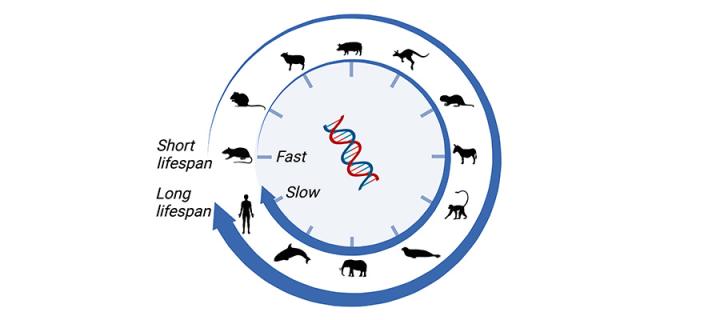DNA methylation rates linked to maximum lifespan in mammals
Researchers from the MRC Human Genetics Unit show slower DNA methylation rates in longer lived mammals, such as whales, compared to shorter lived mammals, like rats: December 2023

Organisms display enormous variation as the result of evolution, spanning many orders of magnitude in characteristics such as size, energy requirements, and lifespan. Despite this remarkable diversity, it has been observed that biological traits often share underlying mechanisms and constraints. These fundamental connections between features of organisms can be reflected in scaling laws, which mathematically describe an association between two physical quantities over several orders of magnitude.
DNA methylation is the addition of a methyl group (-CH3) to certain sites on the DNA. This is an example of an epigenetic mechanism – a change to the DNA molecule without a change to the underlying sequence. Methylation of some sites changes in a predictable way with age. This observation led to the development of the first “epigenetic clocks” which used methylation of selected sites to predict chronological age in humans. This has now been extended to the development of clocks capable of measuring age across mammals. Whether methylation is a driver of aging is an active topic of research.
To provide further insight into the role of methylation in aging, Sam, Eric and Tamir examined methylation rates within blood and skin across mammals and assessed how these scaled with lifespan. They focused on conserved age-related sites and selected a total of 42 mammals that reflect a range of maximum lifespans; from the rat (about 4 years) to the bowhead whale (over 200 years). They found that methylation rates in both tissues scaled negatively with maximum lifespan, with longer-lived mammals exhibiting slower methylation rates than shorter-lived ones.
The fact that specific and quantitative relationships exist between methylation rate and maximum lifespan suggests that there is an evolutionary constraint acting across diverse mammalian lineages. This means that when an organism’s lifespan evolves, its methylation rates also change. A scaling law emerges when these changes occur in a predictable way.
Exactly why we observe this scaling is unclear, but there are a few possibilities. For example, aberrant methylation levels themselves may be an evolutionary constraint on maximum lifespan. Alternatively, it is possible that the scaling is driven by a constraint on an unknown underlying factor.
Related Links
- DNA methylation rates scale with maximum lifespan across mammals published in Nature Aging
- Tamir Chandra Research Group


